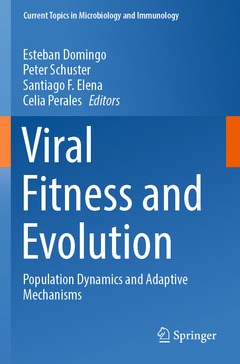Viral Fitness and Evolution, 1st ed. 2023 Population Dynamics and Adaptive Mechanisms Current Topics in Microbiology and Immunology Series, Vol. 439
Coordonnateurs : Domingo Esteban, Schuster Peter, Elena Santiago F., Perales Celia

This book unifies general concepts of plant and animal virus evolution and covers a broad range of topics related to theoretical and experimental aspects of virus population dynamics and viral fitness.
Timely topics such as viral mechanisms to cope with antiviral agents, the adaptability of the virus to new hosts, emergence of new viral phenotypes, and the connections between short- and long-term virus evolution are included.
By comparing plant and animal viruses, universal mechanisms responsible for fitness variations, viral emergence and disease mechanisms are explored.
Although emphasis is put on specific plant and human viral pathogens, relevant similarities and differences to other viruses are highlighted. Additionally, readers will learn more about the adaptability of coronaviruses, including the recently emerged SARS-CoV-2, the causative agent of the COVID-19 pandemic.
The book is aimed at students and scientists interested in basic and applied aspects of plant and animal virus population dynamics and evolution.
Esteban Domingo [B.Sc. in Chemistry (1965), Ph.D. in Biochemistry (1969) from the University of Barcelona, Spain] did postdoctoral work at the UC Irvine, with Robert C. Warner (1969-1973), and at the University of Zürich, with Charles Weissmann (1974-1977). This work permitted the calculation of a mutation rate and the first evidence of quasispecies for an RNA virus. He was visiting Professor at the UC San Diego with John J. Holland (1989-1990), and they provided the first evidence of lethal mutagenesis of RNA viruses. He is Emeritus Professor of Research (CSIC) at Centro de Biología Molecular Severo Ochoa in Madrid. He has received several awards, including the degree of Doctor honoris causa from the Universities of Liège (Belgium) (1999), and Bern (Switzerland) (2004). He is a member of EMBO, the European Academy, Vice-President of the Royal Academy of Sciences of Spain, and in 2020 he was elected Foreign Associate of the US National Academy of Sciences.
Peter Schuster, born 1941 in Vienna, Austria, studied Chemistry at the University of Vienna and got his PhD in 1967. He was Postdoctoral Fellow at the Max-Planck-Institute for Biophysical Chemistry, Göttingen, Germany, and then Full Professor of Theoretical Chemistry, University of Vienna, 1973-2009. Since 2009 he is Professor emeritus. He was External Faculty Member of the Santa Fe Institute, Santa Fe NM, USA, 1991-2020 and Founding Director of the Institute of Molecular Biotechnology, Jena, Germany, 1991-1995. Among other academic memberships he is Fellow of the Austrian Academy of Sciences since 1984, and was Vice President 2000-2003 and President 2006-2009. He is Fellow of the Deutsche Akademie der Naturforscher Leopoldina, Foreign Associate of the National Academy of Sciences, USA, Fellow of the Academia Europaea London and Member of the European Molecular Biology Organization (EMBO). Peter Schuster’s scientific works deal with the theory of intermolecular forces. Tog
Examines viral mechanisms to cope with antiviral agents
Provides insights into viral adaptability to new hosts
Covers the emergence of new viral phenotypes
Date de parution : 01-2024
Ouvrage de 344 p.
15.5x23.5 cm
Disponible chez l'éditeur (délai d'approvisionnement : 15 jours).
Prix indicatif 179,34 €
Ajouter au panierDate de parution : 01-2023
Ouvrage de 344 p.
15.5x23.5 cm
Disponible chez l'éditeur (délai d'approvisionnement : 15 jours).
Prix indicatif 179,34 €
Ajouter au panier


